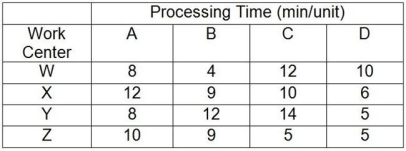Multiple Choice
Table 5.2
A company makes four products that have the following characteristics: Product A sells for $75 but needs $20 of materials and $20 of labor to produce; Product B sells for $90 but needs $45 of materials and $20 of labor to produce; Product C sells for $110 but needs $50 of materials and $30 of labor to produce; Product D sells for $135 but needs $75 of materials and $40 of labor to produce. The processing requirements for each product on each of the four machines are shown in the table.

Work centers W, X, Y, and Z are available for 40 hours per week and have no setup time when switching between products. Market demand is 50 As, 60 Bs, 70 Cs, and 80 Ds per week. In the questions that follow, the traditional method refers to maximizing the contribution margin per unit for each product, and the bottleneck method refers to maximizing the contribution margin per minute at the bottleneck for each product.
-Use the information in Table 5.2. Using the bottleneck method, what is the optimal product mix?
A) 37 A, 60 B, 70 C, 80 D
B) 50 A, 51 B, 70 C, 80 D
C) 50 A, 60 B, 62 C, 80 D
D) 50 A, 60 B, 70 C, 60 D
Correct Answer:

Verified
Correct Answer:
Verified
Q2: The production of a particular product consists
Q3: The third step in Theory of Constraints
Q4: How can Theory of Constraints principles be
Q5: Figure 5.2<br> <img src="https://d2lvgg3v3hfg70.cloudfront.net/TB1252/.jpg" alt="Figure 5.2
Q6: Table 5.2<br>A company makes four products that
Q8: Table 5.2<br>A company makes four products that
Q9: Any factor that limits the performance of
Q10: Describe three ways that line balancing and
Q11: Schmidt Industries makes four different snake traps;
Q12: Table 5.4<br>The Superior Management Company assembles muffalettas